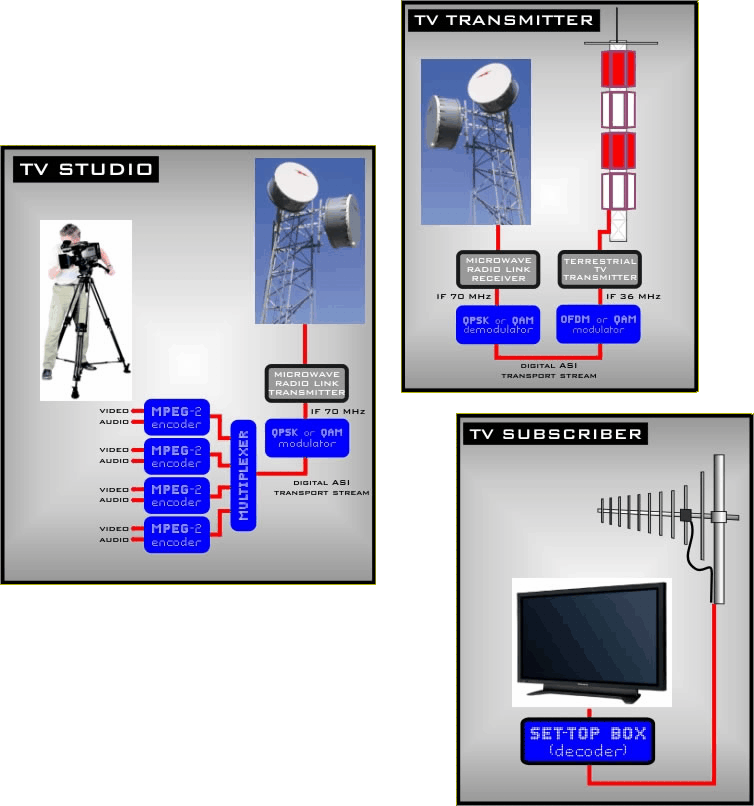|
In the recent period the trend of TV broadcasting is in
continous evolution towards the Digital TV with the introduction of
Digital Television Broadcasting.
Under "Digital TV" it is normally intended terrestrial or
satellite broadcasting of a digital TV signal (DVB-T or DVB-S respectively).
Principal benefits and new features of Digital TV, compared with
traditional analogue broadcasting:
On digital terrestrial transmitter up to 4
or 6 TV programs + additional services
can be transmitted with single TV transmitter using single standard RF channel.
Spectral efficiency is also enhanced, through the use of
Single Frequency Networks (SFNs).
The quality of each of theese programs is
superior compared to the analog transmission.
Digital systems can be used for
standard (better than analogue) or High Definition TV by appropriate allocation
of bit rate capacity.
Resistance to the interferences of the
digital signal is superior - image and sound without any interferences.
The COFDM systems (DVB-T and ISDB) virtually eliminate multipath distortion and
delayed image problems. This improves significantly reception in mountainous,
urban and sea areas.
Data up to 2 Mb/s, can be transmitted
simultaneously with the TV pictures. The data can be picture related (teletext)
or it can be software or an Internet channel for home PC.
There is also the possibility of
"interactive TV services" using MHP standard.
Featuring much lower radiated power for the same coverage
compared with analogue transmission, DTT offers further enhancements to
transmission when using the COFDM standards (the European DVB-T standard).
TYPICAL DIGITAL TV SYSTEM

TV TRANSMITTERS
Tests with digitally modulated signals have shown that
our transmitters can be easily
implemented in versions for COFDM operation, as in the European DVB-T
digital TV system.
The supply of our new digital
terrestrial transmitters, and the upgrading of most existing analogue ones for DTT use, will therefore be a straightforward matter, involving the addition of a
suitable digital modulator, low phase noise/high stability local oscillators,
and the application of the required degree of linearity correction, with output
filtering, to comply with MER (Modulation Error Rate) and band spectrum
specifications.
The precision synthesised local
oscillator system is also available, enabling a network of digital transmitters
to be locked to the universal GPS standard, using an inexpensive receiver. This
is especially suitable for SFN implementation.
MICROWAVE LINKS
We also deliver a very cost
effective range of Microwave Links which can be adapted for either fixed or
portable use at frequencies which range from 1.5 GHz to 24 GHz.
Digital Links for transporting digitally modulated signals;
those using QPSK (Quadrature Phase Shift Keying) or QAM (Quadrature Amplitude
Modulation), require a higher order of linearity than do conventional FM links.
With QAM modulation particularly, the carrier can assume a potentially large
number of phase and amplitude states, so the phase and amplitude linearity of
the link transmitter and receiver are required to be of a higher order than for
FM analogue links.
Also, excess phase noise prior to demodulation can give rise
to an increase in the Bit Error Ratio (BER).
Summarising, the main differences of digital compared with
analogue links:
-
Digital Modulator and
Demodulator are required, suitable for the digital system to be used, to
interface at IF 70 MHz;
-
A higher degree of phase and
amplitude linearity is required in the RF part of the link system;
-
Lower phase noise, with better
frequency stability, is required in both transmitter and receiver local
oscillators;
We employ only linear Class A
amplifiers in Link transmitters and receiver front ends. New series Links are
available without limiters (which would introduce non linearity) and with high
local oscillator performance.
Both fixed and portable links can be supplied with either
digital or analogue modulators and demodulators. Because both types employ 70
MHz IF interface, customers can upgrade from analogue to digital at a later
date, therefore an initial investment in a "new series" analogue Link system may
be regarded as a future proof investment.
For more information about the equipment neccessary for the
digital TV broadcasting you can also consult the following product pages:
New Products
Digital TV Broadcasting DVB-T
Digital MPEG-2 Equipment
|



